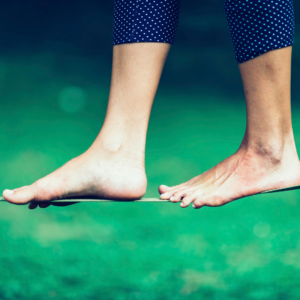
Balance – a matter of life and death. The British Journal of Sports Medicine published the results of a decade-long study involving more than 1,700 middle-aged participants, which concluded that an inability to balance was associated with an almost twofold increase in risk of death. This sounds frightening but we can do something about it! Incorporating balance exercise into your daily routine from a much younger age than you think, can really help maintain stability in older age.
The Importance of Balance Exercise: Maintaining Stability and Preventing Falls
Balance exercise is a crucial component of any well-rounded fitness routine, yet it is often overlooked or underestimated. While activities like cardio and strength training tend to take the spotlight, incorporating balance exercises into your workout regimen offers numerous benefits that go beyond physical fitness. Balance exercises help improve stability, prevent falls, enhance coordination, and promote overall well-being. In this article, we will delve into the significance of balance exercise and why it should be an essential part of everyone’s fitness routine.
Maintaining Stability:
Balance is the foundation of stability. It is the ability to control and maintain body position while performing various tasks or activities. Good balance is essential for everyday activities such as walking, climbing stairs, and standing up from a seated position. Balance exercises focus on strengthening the muscles that support stability, including the core, legs, and ankles. By improving these muscle groups, you enhance your ability to stay upright and steady, reducing the risk of falls and injuries.
Preventing Falls:
Falls can have severe consequences, especially for older adults. According to the World Health Organization (WHO), falls are the second leading cause of accidental injury and death worldwide. Engaging in balance exercises can significantly reduce the risk of falls by improving muscle strength, coordination, and proprioception—the body’s ability to sense its position in space. By practicing exercises that challenge your balance, such as standing on one leg or performing heel-to-toe walks, you enhance your body’s ability to adapt to unstable surfaces and react quickly to changes in your environment.
Enhancing Coordination:
Balance exercises also contribute to improved coordination. Coordination involves the harmonious functioning of different muscle groups and body parts, enabling smooth movements and precise control. When you perform balance exercises, you engage various muscle groups simultaneously, encouraging them to work together in a coordinated manner. This enhanced coordination translates into better motor skills, increased agility, and improved performance in sports and physical activities.
Promoting Overall Well-being:
Regular balance exercise not only benefits physical health but also promotes overall well-being. As you challenge your body’s balance and stability, you activate the neuromuscular system, which stimulates the brain and improves cognitive function. Studies have shown that balance exercises can enhance brain connectivity, boost concentration, and even reduce the risk of age-related cognitive decline. Moreover, balance exercises can help alleviate stress, improve mood, and enhance self-confidence, providing a positive impact on mental and emotional health. Feeling confident with your balance enables you to move more easily, which means you feel more able to walk and leave the house safely.
Incorporating Balance Exercises into Your Routine:
Fortunately, incorporating balance exercises into your fitness routine doesn’t require much time or equipment. There are numerous simple exercises that can be done at home or in a gym setting. Some examples include standing on one leg, heel-to-toe walks, yoga poses like tree pose or warrior pose, and using balance boards or stability balls. It is important to start with exercises that suit your current level of balance and gradually progress as you become more comfortable and confident.
Remember to prioritise safety when performing balance exercises. Have a stable surface nearby for support if needed, and start with exercises that have a lower risk of injury.
Our physiotherapy team are specialist in prescribing balance exercises based on a thorough assessment. We incorporate NICE and CSP guidelines into our programs. We use Tai Chi, Otago, postural exercises, yoga, pilates, seated and standing balance sessions. Do contact us about how we can help you no matter your current ability.
In conclusion, balance exercise is a critical aspect of maintaining stability, preventing falls, enhancing coordination, and promoting overall well-being. By dedicating a small portion of your fitness routine to balance exercises, you can reap the numerous benefits and improve your quality of life. So, let’s prioritise balance and stability to be healthy, confident and well.



